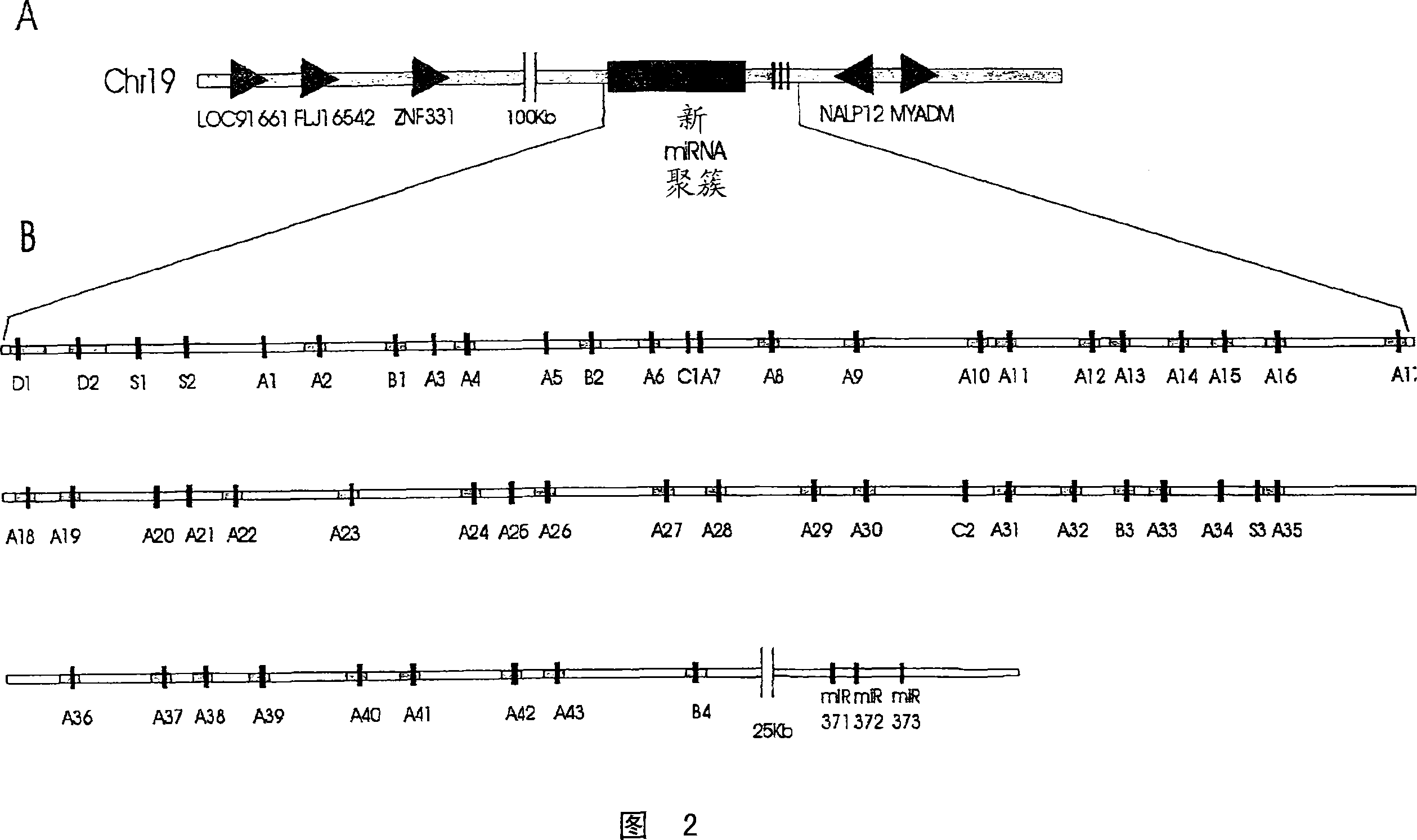Microrna and uses thereof
A sequence and nucleic acid technology, applied in the field of microRNA and its application, can solve problems such as difficult identification of miRNAs
- Summary
- Abstract
- Description
- Claims
- Application Information
AI Technical Summary
Problems solved by technology
Method used
Image
Examples
Embodiment 1
[0142] miRNA prediction
[0143] We used two in silico methods similar to those used to predict miRNAs described in U.S. Patent Application Nos. 60 / 522,459, 10 / 709,577, and 10 / 709,572, the contents of which are incorporated herein by reference, for potential miRNA-encoding gene pairs. The entire human genome was examined. Briefly, nonprotein-coding regions of the entire human genome were scanned for hairpin structures. Predicted hairpin structures and potential miRNAs were scored according to thermodynamic stability as well as structural and contextual features. Validated miRNA calibration algorithms from the Sanger database were used.
[0144] 1. First Screening
[0145] Tables 11A-11C show the sequence ("precursor sequence"), sequence identifier ("PRECUR SEQ-ID"), and organism of origin ("GAM organism") and Predicted miRNAs ("GAM names"). Table 12 shows the sequence ("GAM RNA sequence") and sequence identifier ("GAM SEQ-ID") of each miRNA ("GAM na...
Embodiment 2
[0154] Prediction of target genes
[0155] The 2 in silico screens from Example 1 were then combined using in silico methods similar to those described in U.S. Patent Application Nos. 60 / 522,459, 10 / 709,577, and 10 / 709,572 (the contents of which are incorporated herein by reference) for predicting The predicted miRNAs are used to predict target genes and their binding sites.
[0156] 1. The first screening
[0157] Tables 13A-13C list the predicted target gene (“Target”) and binding site sequence (“Target Binding Site Sequence”) and binding site sequence identifier (“Target Binding Site SEQ-ID"), and the organism of origin of the target ("target organism"). Table 14 lists diseases ("Disease Names") associated with target genes ("Disease-Associated Target Genes"). Table 15 lists miRNA sequence identifiers ("SEQ ID NOs of GAMS associated with diseases") and diseases associated with miRNAs based on target genes ("Disease Name"). The sequences of the bind...
Embodiment 3
[0164] Validation of miRNA
[0165] 1. Expression Analysis - Group 1
[0166] To determine predicted hairpin structures and miRNAs on 0, we used high-throughput microarrays similar to those described in US Patent Application Nos. 60 / 522,459, 10 / 709,577 and 10 / 709,572, the contents of which are incorporated herein by reference Arrays detect expression in various tissues. For each predicted precursor miRNA, mature miRNAs derived from the two stems of the hairpin were examined.
[0167] Table 2 shows the hairpin structure ("HID") of the second predicted panel validated by detecting the expression of the associated miRNA ("MID"), and the code of the tissue ("tissue") in which expression was detected. The codes for the tissues and diseases of Table 2 are listed in Table 7. Some of the tissues tested are cell lines. The lung cancer cell line (H1299) with / without P53:H1299 has mutated P53. Cell lines were transfected with such a construct with P53, whic...
PUM
 Login to View More
Login to View More Abstract
Description
Claims
Application Information
 Login to View More
Login to View More - R&D
- Intellectual Property
- Life Sciences
- Materials
- Tech Scout
- Unparalleled Data Quality
- Higher Quality Content
- 60% Fewer Hallucinations
Browse by: Latest US Patents, China's latest patents, Technical Efficacy Thesaurus, Application Domain, Technology Topic, Popular Technical Reports.
© 2025 PatSnap. All rights reserved.Legal|Privacy policy|Modern Slavery Act Transparency Statement|Sitemap|About US| Contact US: help@patsnap.com



